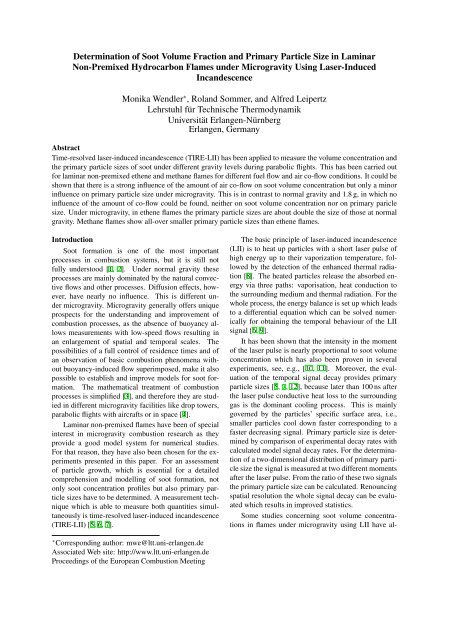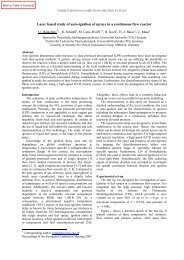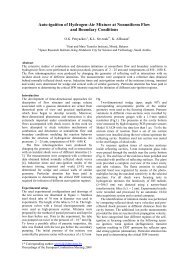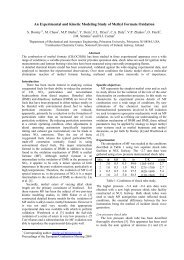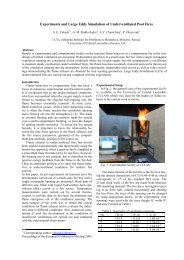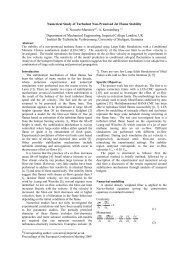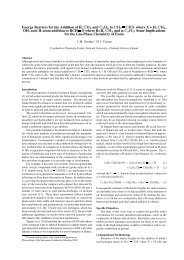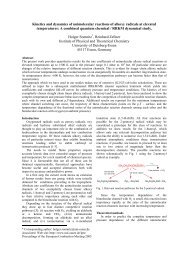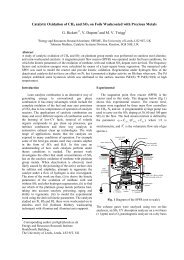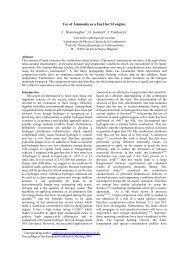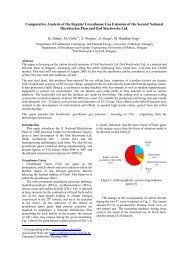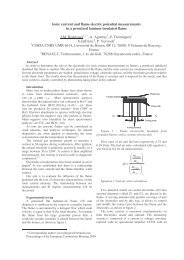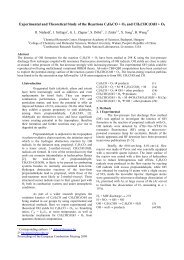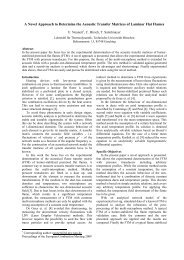Determination of Soot Volume Fraction and Primary Particle Size in ...
Determination of Soot Volume Fraction and Primary Particle Size in ...
Determination of Soot Volume Fraction and Primary Particle Size in ...
You also want an ePaper? Increase the reach of your titles
YUMPU automatically turns print PDFs into web optimized ePapers that Google loves.
<strong>Determ<strong>in</strong>ation</strong> <strong>of</strong> <strong>Soot</strong> <strong>Volume</strong> <strong>Fraction</strong> <strong>and</strong> <strong>Primary</strong> <strong>Particle</strong> <strong>Size</strong> <strong>in</strong> Lam<strong>in</strong>ar<br />
Non-Premixed Hydrocarbon Flames under Microgravity Us<strong>in</strong>g Laser-Induced<br />
Inc<strong>and</strong>escence<br />
Monika Wendler ∗ , Rol<strong>and</strong> Sommer, <strong>and</strong> Alfred Leipertz<br />
Lehrstuhl für Technische Thermodynamik<br />
Universität Erlangen-Nürnberg<br />
Erlangen, Germany<br />
Abstract<br />
Time-resolved laser-<strong>in</strong>duced <strong>in</strong>c<strong>and</strong>escence (TIRE-LII) has been applied to measure the volume concentration <strong>and</strong><br />
the primary particle sizes <strong>of</strong> soot under different gravity levels dur<strong>in</strong>g parabolic flights. This has been carried out<br />
for lam<strong>in</strong>ar non-premixed ethene <strong>and</strong> methane flames for different fuel flow <strong>and</strong> air co-flow conditions. It could be<br />
shown that there is a strong <strong>in</strong>fluence <strong>of</strong> the amount <strong>of</strong> air co-flow on soot volume concentration but only a m<strong>in</strong>or<br />
<strong>in</strong>fluence on primary particle size under microgravity. This is <strong>in</strong> contrast to normal gravity <strong>and</strong> 1.8 g, <strong>in</strong> which no<br />
<strong>in</strong>fluence <strong>of</strong> the amount <strong>of</strong> co-flow could be found, neither on soot volume concentration nor on primary paricle<br />
size. Under microgravity, <strong>in</strong> ethene flames the primary particle sizes are about double the size <strong>of</strong> those at normal<br />
gravity. Methane flames show all-over smaller primary particle sizes than ethene flames.<br />
Introduction<br />
<strong>Soot</strong> formation is one <strong>of</strong> the most important<br />
processes <strong>in</strong> combustion systems, but it is still not<br />
fully understood [1, 2]. Under normal gravity these<br />
processes are ma<strong>in</strong>ly dom<strong>in</strong>ated by the natural convective<br />
flows <strong>and</strong> other processes. Diffusion effects, however,<br />
have nearly no <strong>in</strong>fluence. This is different under<br />
microgravity. Microgravity generally <strong>of</strong>fers unique<br />
prospects for the underst<strong>and</strong><strong>in</strong>g <strong>and</strong> improvement <strong>of</strong><br />
combustion processes, as the absence <strong>of</strong> buoyancy allows<br />
measurements with low-speed flows result<strong>in</strong>g <strong>in</strong><br />
an enlargement <strong>of</strong> spatial <strong>and</strong> temporal scales. The<br />
possibilities <strong>of</strong> a full control <strong>of</strong> residence times <strong>and</strong> <strong>of</strong><br />
an observation <strong>of</strong> basic combustion phenomena without<br />
buoyancy-<strong>in</strong>duced flow superimposed, make it also<br />
possible to establish <strong>and</strong> improve models for soot formation.<br />
The mathematical treatment <strong>of</strong> combustion<br />
processes is simplified [3], <strong>and</strong> therefore they are studied<br />
<strong>in</strong> different microgravity facilities like drop towers,<br />
parabolic flights with aircrafts or <strong>in</strong> space [4].<br />
Lam<strong>in</strong>ar non-premixed flames have been <strong>of</strong> special<br />
<strong>in</strong>terest <strong>in</strong> microgravity combustion research as they<br />
provide a good model system for numerical studies.<br />
For that reason, they have also been chosen for the experiments<br />
presented <strong>in</strong> this paper. For an assessment<br />
<strong>of</strong> particle growth, which is essential for a detailed<br />
comprehension <strong>and</strong> modell<strong>in</strong>g <strong>of</strong> soot formation, not<br />
only soot concentration pr<strong>of</strong>iles but also primary particle<br />
sizes have to be determ<strong>in</strong>ed. A measurement technique<br />
which is able to measure both quantities simultaneously<br />
is time-resolved laser-<strong>in</strong>duced <strong>in</strong>c<strong>and</strong>escence<br />
(TIRE-LII) [5, 6, 7].<br />
∗ Correspond<strong>in</strong>g author: mwe@ltt.uni-erlangen.de<br />
Associated Web site: http://www.ltt.uni-erlangen.de<br />
Proceed<strong>in</strong>gs <strong>of</strong> the European Combustion Meet<strong>in</strong>g<br />
The basic pr<strong>in</strong>ciple <strong>of</strong> laser-<strong>in</strong>duced <strong>in</strong>c<strong>and</strong>escence<br />
(LII) is to heat up particles with a short laser pulse <strong>of</strong><br />
high energy up to their vaporization temperature, followed<br />
by the detection <strong>of</strong> the enhanced thermal radiation<br />
[8]. The heated particles release the absorbed energy<br />
via three paths: vaporisation, heat conduction to<br />
the surround<strong>in</strong>g medium <strong>and</strong> thermal radiation. For the<br />
whole process, the energy balance is set up which leads<br />
to a differential equation which can be solved numerically<br />
for obta<strong>in</strong><strong>in</strong>g the temporal behaviour <strong>of</strong> the LII<br />
signal [6, 9].<br />
It has been shown that the <strong>in</strong>tensity <strong>in</strong> the moment<br />
<strong>of</strong> the laser pulse is nearly proportional to soot volume<br />
concentration which has also been proven <strong>in</strong> several<br />
experiments, see, e.g., [10, 11]. Moreover, the evaluation<br />
<strong>of</strong> the temporal signal decay provides primary<br />
particle sizes [5, 7, 12], because later than 100 ns after<br />
the laser pulse conductive heat loss to the surround<strong>in</strong>g<br />
gas is the dom<strong>in</strong>ant cool<strong>in</strong>g process. This is ma<strong>in</strong>ly<br />
governed by the particles’ specific surface area, i.e.,<br />
smaller particles cool down faster correspond<strong>in</strong>g to a<br />
faster decreas<strong>in</strong>g signal. <strong>Primary</strong> particle size is determ<strong>in</strong>ed<br />
by comparison <strong>of</strong> experimental decay rates with<br />
calculated model signal decay rates. For the determ<strong>in</strong>ation<br />
<strong>of</strong> a two-dimensional distribution <strong>of</strong> primary particle<br />
size the signal is measured at two different moments<br />
after the laser pulse. From the ratio <strong>of</strong> these two signals<br />
the primary particle size can be calculated. Renounc<strong>in</strong>g<br />
spatial resolution the whole signal decay can be evaluated<br />
which results <strong>in</strong> improved statistics.<br />
Some studies concern<strong>in</strong>g soot volume concentrations<br />
<strong>in</strong> flames under microgravity us<strong>in</strong>g LII have al-
eady been done [13, 14]. In the present work, not only<br />
soot volume concentrations but also primary particle<br />
sizes have been measured spatially resolved <strong>in</strong> lam<strong>in</strong>ar<br />
non-premixed ethene <strong>and</strong> methane flames. A special<br />
<strong>in</strong>terest was set on the <strong>in</strong>fluence <strong>of</strong> the variation <strong>of</strong> air<br />
co-flow on soot parameters under different gravity conditions.<br />
The emphasis <strong>of</strong> this paper is the description<br />
<strong>of</strong> the phenomena discovered. Only some <strong>of</strong> the results<br />
obta<strong>in</strong>ed could have been expla<strong>in</strong>ed so far <strong>and</strong> will be<br />
the subject <strong>of</strong> future experimental an theoretical work.<br />
Experimental Setup<br />
The experiments have been carried out dur<strong>in</strong>g an<br />
ESA parabolic flight campaign aboard an Airbus A300<br />
aircraft. Each parabola was <strong>in</strong>itiated <strong>and</strong> closed by a<br />
time period <strong>of</strong> <strong>in</strong>creased gravity (1.8 g), embedd<strong>in</strong>g an<br />
about 20 second period <strong>of</strong> microgravity. Thus, <strong>in</strong>clud<strong>in</strong>g<br />
the time between two parabolas, the flames could be<br />
observed under three different gravity conditions. Due<br />
to safety reasons aboard the aircraft, the setup had to<br />
be completely <strong>in</strong>tegrated <strong>in</strong> a rack, as shown <strong>in</strong> Fig. 1.<br />
The burner was <strong>in</strong>stalled <strong>in</strong>side a chamber connected<br />
to the exhaust l<strong>in</strong>e <strong>of</strong> the overboard ventilation system.<br />
The burner chamber was equipped with four optical<br />
w<strong>in</strong>dows for the access to the measurement location.<br />
Magnetic <strong>and</strong> flame-non-return valves were <strong>in</strong>stalled to<br />
ensure a safe operation <strong>of</strong> the gas supply, <strong>and</strong> all relevant<br />
parameters were controlled automatically, especially<br />
the amount <strong>of</strong> fuel <strong>and</strong> air co-flow, which was varied<br />
systematically to determ<strong>in</strong>e the <strong>in</strong>fluence <strong>of</strong> these<br />
parameters on soot formation under microgravity. The<br />
burner itself consisted <strong>of</strong> two concentric tubes, the <strong>in</strong>ner<br />
one (2.2 mm <strong>in</strong> diameter) for fuel (ethene or methane)<br />
the outer one (30 mm <strong>in</strong> diameter) for air co-flow (synthetic<br />
air 20.5 % O2, 79.5 % N2). Besides, a second air<br />
co-flow was <strong>in</strong>tegrated to prevent the dimm<strong>in</strong>g <strong>of</strong> the<br />
optical w<strong>in</strong>dows by condensed vapour.<br />
Laser power supply<br />
Laser head<br />
Monitor #1 Monitor #2<br />
Electronics Camera controller #1 Camera controller #2<br />
ICCD camera #2<br />
burner<br />
chamber<br />
Figure 1: Schematical draw<strong>in</strong>g <strong>of</strong> the experimental setup<br />
The setup was chosen as a result <strong>of</strong> the experience<br />
<strong>of</strong> an earlier campaign with a different burner<br />
configuration, where the flame structures had been disturbed<br />
by short periods <strong>of</strong> negative gravity forces dur<strong>in</strong>g<br />
the parabolas, result<strong>in</strong>g <strong>in</strong> a complete collapse <strong>of</strong> the<br />
ICCD camera #1<br />
2<br />
flames. The actual layout was constructed to be able to<br />
<strong>in</strong>crease the gas flows, provid<strong>in</strong>g more stable flames.<br />
Nevertheless, also <strong>in</strong> this new experimental approach<br />
the flame shape was affected by g-jitter which<br />
will be described <strong>in</strong> detail later. The soot particles were<br />
heated up to their vaporisation temperature by us<strong>in</strong>g<br />
a frequency-doubled Nd:YAG laser with a pulse frequency<br />
<strong>of</strong> 10 Hz <strong>and</strong> a pulse duration <strong>of</strong> 6 ns. The beam<br />
was formed to a light sheet with a width <strong>of</strong> 3 cm <strong>and</strong><br />
a thickness <strong>of</strong> 0.5 cm which leads to an irradiance <strong>of</strong><br />
1·10 8 W/cm 2 for a typical pulse energy <strong>of</strong> 75 mJ. Modifications<br />
<strong>of</strong> the laser were done by the manufacturer<br />
to ensure functionality under microgravity conditions.<br />
Thus, a variation <strong>of</strong> laser output was not expected <strong>and</strong><br />
there was no cont<strong>in</strong>uous control <strong>of</strong> pulse energy dur<strong>in</strong>g<br />
the flight <strong>in</strong>stalled. It was only measured prior <strong>and</strong> after<br />
every flight <strong>in</strong>dicat<strong>in</strong>g no differences. In the course <strong>of</strong><br />
the data evaluation, however, <strong>in</strong>dications for laser pulse<br />
energy fluctuations appeared. This poses an uncerta<strong>in</strong>ty<br />
especially on the results <strong>of</strong> the primary particle size determ<strong>in</strong>ation.<br />
The reason for this unreliable behaviour<br />
<strong>of</strong> the laser under microgravity has not been found yet.<br />
The LII signal was detected by us<strong>in</strong>g two ICCD cameras,<br />
placed opposite each other, perpendicular to the<br />
laser beam, as it can be seen <strong>in</strong> Fig. 1. It turned out<br />
that the camera sensitivity varied up to 25 % between<br />
two follow<strong>in</strong>g images. In addition, the extent <strong>of</strong> this effect<br />
was dependent on the chosen <strong>in</strong>tensifier ga<strong>in</strong> value.<br />
Thus, the results for ethene flames <strong>and</strong> methane flames<br />
cannot be compared quantitatively as different ga<strong>in</strong> values<br />
had to be used due to lower soot concentrations <strong>in</strong><br />
the methane flame. Nevertheless, a lot <strong>of</strong> valuable <strong>in</strong>formation<br />
could be acquired, which will be presented<br />
hereafter.<br />
The maximum signal was captured by one <strong>of</strong> the<br />
cameras <strong>and</strong> compared later to a s<strong>in</strong>gle l<strong>in</strong>e-<strong>of</strong>-sight ext<strong>in</strong>ction<br />
measurement for calibration <strong>in</strong> order to get <strong>in</strong>formation<br />
on the absolute soot volume concentration.<br />
For the determ<strong>in</strong>ation <strong>of</strong> the primary particle sizes the<br />
LII signal decay was evaluated by detect<strong>in</strong>g at two different<br />
times, 100 ns <strong>and</strong> 400 ns after the laser pulse.<br />
From the signal ratio the signal decay time constant<br />
can be calculated. Tak<strong>in</strong>g <strong>in</strong>to consideration the ambient<br />
temperature this ratio is unambiguously related<br />
to the primary particle size. Unfortunately, due to experimental<br />
problems, we have no <strong>in</strong>formation about the<br />
temperature distribution <strong>in</strong> the exam<strong>in</strong>ed flames. Therefore,<br />
temperature <strong>in</strong>formation from measurements performed<br />
at the ZARM drop tower <strong>in</strong> Bremen, Germany,<br />
by project partners us<strong>in</strong>g the same burner configuration,<br />
fuel <strong>and</strong> air co-flow parameters were used for data evaluation.<br />
Results <strong>and</strong> Discussion<br />
Flame behaviour Dur<strong>in</strong>g most <strong>of</strong> the parabolas the<br />
<strong>in</strong>fluence <strong>of</strong> reduced gravity <strong>and</strong> the typical behaviour
under microgravity could be observed [15, 16]. All <strong>in</strong>vestigated<br />
flames were broadened under microgravity<br />
<strong>and</strong> longer as their counterparts under normal gravity.<br />
However, the change <strong>of</strong> flame shape under µg was dependent<br />
on the chosen gas <strong>and</strong> air flows. Some ethene<br />
flames show no open tip under microgravity (see Fig. 3<br />
<strong>and</strong> Fig. 4).<br />
Figure 2: Sequence <strong>of</strong> LII-Signals dur<strong>in</strong>g a collapse <strong>of</strong> a<br />
flame due to g-jitter<br />
Nevertheless, <strong>in</strong> some cases, short periods <strong>of</strong> negative<br />
g-forces <strong>in</strong>duced a fast breakdown <strong>of</strong> the flame.<br />
Fig. 2 shows the LII-signal <strong>of</strong> an ethene flame <strong>in</strong> an exemplary<br />
case. Unfortunately, even without flame breakdown,<br />
the exact evaluation <strong>of</strong> the measurements still reveals<br />
a strong <strong>in</strong>fluence <strong>of</strong> fluctuations <strong>in</strong> the quality<br />
<strong>of</strong> microgravity on the flame shape. The behaviour <strong>of</strong><br />
the flame dur<strong>in</strong>g the parabolas is not only determ<strong>in</strong>ed<br />
by the absolute value <strong>of</strong> rema<strong>in</strong><strong>in</strong>g gravity, but depends<br />
also on the course <strong>of</strong> the g-level dur<strong>in</strong>g the beg<strong>in</strong>n<strong>in</strong>g <strong>of</strong><br />
the parabola. Thus, a steep gradient with a slight overturn<br />
<strong>in</strong>to the region <strong>of</strong> negative accelerations causes a<br />
different flame shape than a smooth beg<strong>in</strong>n<strong>in</strong>g <strong>of</strong> the<br />
µg-phase with some time <strong>of</strong> negative g. The latter behaviour<br />
results more <strong>of</strong>ten <strong>in</strong> a collaps<strong>in</strong>g flame. As<br />
the effect <strong>of</strong> g-jtter is stronger <strong>in</strong> flames with low flow<br />
rates, <strong>in</strong> future campaigns a compromise must be found<br />
<strong>in</strong> chos<strong>in</strong>g flow rates both lead<strong>in</strong>g to stable flames <strong>and</strong><br />
show<strong>in</strong>g the effects <strong>of</strong> microgravity.<br />
3<br />
<strong>Soot</strong> volume concentration Figures 3 <strong>and</strong> 4 show<br />
the soot volume concentration for ethene flames under<br />
variation <strong>of</strong> air co-flow rate <strong>and</strong> ethene flow rate respectively.<br />
Figure 3: <strong>Soot</strong> volume concentration for different ethene<br />
flow rates (<strong>in</strong> ppmv): 75 scm3 /m<strong>in</strong> (a <strong>and</strong> c) <strong>and</strong><br />
100 scm3 /m<strong>in</strong> (b <strong>and</strong> d); air co-flow rate: 10 sl/m<strong>in</strong><br />
Figure 4: <strong>Soot</strong> volume concentration for different air co-flow<br />
rates (<strong>in</strong> ppmv): 15 sl/m<strong>in</strong> (a <strong>and</strong> d), 10 sl/m<strong>in</strong> (b <strong>and</strong> e),<br />
<strong>and</strong> 8 sl/m<strong>in</strong> (c <strong>and</strong> f); ethene flow rate: 75 scm3 /m<strong>in</strong><br />
For the variation <strong>of</strong> air co-flow <strong>in</strong> ethene flames a<br />
rather strong <strong>in</strong>fluence <strong>of</strong> the amount <strong>of</strong> air co-flow on<br />
soot volume fraction <strong>and</strong> its distribution <strong>in</strong> the flame<br />
can be observed under microgravity. As it can be seen<br />
<strong>in</strong> Fig. 4, soot volume concentration <strong>in</strong>creases with<br />
ris<strong>in</strong>g ethene flow rate <strong>in</strong> outer flame regions <strong>and</strong> decreases<br />
with fall<strong>in</strong>g air co-flow <strong>in</strong> the <strong>in</strong>ner flame regions<br />
result<strong>in</strong>g <strong>in</strong> an <strong>in</strong>creased soot formation <strong>in</strong> a narrow<br />
b<strong>and</strong> at the outer regions. This is <strong>in</strong> contrast to<br />
observations under normal gravity. A variation <strong>of</strong> air<br />
co-flow has no significant <strong>in</strong>fluence on the amount <strong>of</strong><br />
soot produced <strong>in</strong> the exam<strong>in</strong>ed flames under buoyant<br />
conditions.<br />
The <strong>in</strong>fluence <strong>of</strong> the variation <strong>of</strong> ethene flow rate is<br />
shown <strong>in</strong> Fig. 3. Under normal gravity, only the amount<br />
<strong>of</strong> soot produced rises with an <strong>in</strong>crease <strong>of</strong> ethene flow<br />
rate, the distribution <strong>of</strong> soot <strong>in</strong> the flames rema<strong>in</strong>s extensively<br />
constant. In contrast to that, there is a decrease<br />
<strong>of</strong> soot volume concentration <strong>in</strong> <strong>in</strong>ner flame regions <strong>and</strong><br />
an <strong>in</strong>crease <strong>in</strong> outer flame regions. The results obta<strong>in</strong>ed<br />
dur<strong>in</strong>g the 1.8 g phase are not shown, as the flames behave<br />
similar to the 1 g flames. An explanation for this<br />
difference <strong>in</strong> soot distribution between 1 g <strong>and</strong> µg can<br />
be found <strong>in</strong> the temperature distribution <strong>in</strong> the flames<br />
which is several hundred degrees lower <strong>in</strong> the micro-
gravity flames than at normal gravity, result<strong>in</strong>g <strong>in</strong> overall,<br />
but also local larger soot production.<br />
The results <strong>of</strong> the experiments with methane reveal<br />
a different soot distribution under microgravity than<br />
for the ethene flames (see Fig. 5). The soot distribution<br />
is more concentrated <strong>in</strong> the <strong>in</strong>ner flame regions<br />
<strong>and</strong> nearly <strong>in</strong>dependent <strong>of</strong> the magnitude <strong>of</strong> the air c<strong>of</strong>low.<br />
The soot concentration is overall lower than <strong>in</strong><br />
ethene flames. Regard<strong>in</strong>g the <strong>in</strong>fluence <strong>of</strong> the variation<br />
<strong>of</strong> the air co-flow no difference between the 1 g <strong>and</strong><br />
1.8 g phase could be observed.<br />
Figure 5: <strong>Soot</strong> volume concentration (<strong>in</strong> a. u.) for methane<br />
flames under microgravity (left) <strong>and</strong> normal gravity<br />
(right)<br />
<strong>Primary</strong> particle sizes Furthermore, the primary<br />
particle size distribution has been determ<strong>in</strong>ed <strong>in</strong>side the<br />
flame for different fuels <strong>and</strong> air co-flow rates. As mentioned<br />
above, there were <strong>in</strong>dications for unstable laser<br />
operation dur<strong>in</strong>g the µg phase result<strong>in</strong>g <strong>in</strong> a clearly<br />
lower pulse energies. The presented results are based<br />
on the assumption <strong>of</strong> an irradiance <strong>of</strong> 5 MW/cm 2 . A temperature<br />
distribution with a temperature gradient from<br />
1700 K to 1400 K <strong>in</strong> microgravity was chosen <strong>in</strong> agreement<br />
with drop-tower measurements, <strong>and</strong> an uniform<br />
temperature <strong>of</strong> 1800 K for 1 g (obta<strong>in</strong>ed <strong>in</strong> previous<br />
ground-based measurements with the same setup).<br />
The reduced flame temperature under microgravity<br />
can be expected due to the larger residence time <strong>of</strong> particles<br />
<strong>in</strong> the flame <strong>and</strong> the <strong>in</strong>creased radiation losses.<br />
Figure 6: <strong>Primary</strong> particle sizes (<strong>in</strong> nm) for different air c<strong>of</strong>low<br />
rates: 8 sl/m<strong>in</strong> (a, d), 7 sl/m<strong>in</strong> (b, e), 5 sl/m<strong>in</strong> (c, f);<br />
fuel flow rate: 75 scm3 /m<strong>in</strong> under microgravity (a-c)<br />
<strong>and</strong> 1 g (d-e)<br />
It can be seen <strong>in</strong> Fig. 6 that there is only a m<strong>in</strong>or<br />
<strong>in</strong>fluence <strong>of</strong> air co-flow at 1 g as well as at 0 g. Under<br />
4<br />
microgravity, the largest particles can be found <strong>in</strong> the<br />
same narrow b<strong>and</strong> at outer flame regions where large<br />
soot concentrations have been measured (see Fig. 3 <strong>and</strong><br />
Fig. 4). Compared to microgravity, under normal gravity<br />
the maximum primary particle sizes are about half<br />
the values which have been found under microgravity.<br />
This may be due to the extended residence time <strong>of</strong> particles<br />
<strong>in</strong> the flame under microgravity <strong>and</strong> the lower surround<strong>in</strong>g<br />
gas temperatures.<br />
For the methane flame, the results under microgravity<br />
are displayed <strong>in</strong> Fig. 7. The particles are smaller<br />
than <strong>in</strong> the ethene flames <strong>and</strong> more equally distributed<br />
over the flame body which has also been found for the<br />
soot volume concentration (Fig. 5). Aga<strong>in</strong>, the <strong>in</strong>fluence<br />
<strong>of</strong> air co-flow on primary particle sizes is very<br />
low. Under normal gravity, the soot volume concentration<br />
was too low to measure particle sizes.<br />
Figure 7: <strong>Primary</strong> particle sizes (<strong>in</strong> nm) <strong>in</strong> methane flames<br />
under microgravity for different air co-flow rates:<br />
a) 15 sl/m<strong>in</strong>, b) 10 sl/m<strong>in</strong>; methane flow rate: 110 scm3 /m<strong>in</strong><br />
Conclusions<br />
Experiments on ethene <strong>and</strong> methane flames <strong>in</strong> different<br />
gravity environments have been performed. In<br />
ethene flames, under microgravity soot volume fraction<br />
<strong>in</strong>creases with ris<strong>in</strong>g fuel flow rates <strong>and</strong> decreases with<br />
fall<strong>in</strong>g air co-flow <strong>in</strong> <strong>in</strong>ner flame regions result<strong>in</strong>g <strong>in</strong> an<br />
<strong>in</strong>creased soot formation <strong>in</strong> a narrow b<strong>and</strong> <strong>in</strong> the outer<br />
regions. The <strong>in</strong>fluence <strong>of</strong> a variation <strong>of</strong> air co-flow on<br />
primary particle sizes is rather low, compared to 1 g,<br />
primary particle sizes are roughly doubled under µg.<br />
Neither under normal gravity nor under <strong>in</strong>creased gravity<br />
any <strong>in</strong>fluence <strong>of</strong> air co-flow on the soot<strong>in</strong>g behaviour<br />
could be found, the flames are <strong>in</strong> general very similar<br />
under 1 g <strong>and</strong> 1.8 g. In methane flames, the soot volume<br />
concentration showed a different behaviour under<br />
microgravity than <strong>in</strong> ethene flames, be<strong>in</strong>g more concentrated<br />
<strong>in</strong> the <strong>in</strong>ner regions <strong>of</strong> the flame <strong>and</strong> nearly<br />
<strong>in</strong>dependent on the air co-flow. The absolute values<br />
were overall lower than <strong>in</strong> ethene flames, <strong>and</strong> significantly<br />
smaller particle sizes have been found. TIRE-LII<br />
has been proven to be a suitable non-<strong>in</strong>vasive technique<br />
for measur<strong>in</strong>g the soot<strong>in</strong>g characteristics <strong>of</strong> flames under<br />
microgravity, provid<strong>in</strong>g spatially resolved <strong>in</strong>forma-
tion on soot volume concentration <strong>and</strong> primary particle<br />
sizes.<br />
Acknowledgements<br />
The authors gratefully acknowledge f<strong>in</strong>ancial support<br />
for parts <strong>of</strong> the work by the European Space<br />
Agency (ESA) <strong>and</strong> by the German National Science<br />
Foundation (DFG).<br />
References<br />
[1] I. M. Kennedy, Models <strong>of</strong> soot formation <strong>and</strong> oxidation,<br />
Progress <strong>in</strong> Energy <strong>and</strong> Combustion Science<br />
23 (2) (1997) 95–132.<br />
[2] H. Bockhorn (Ed.), <strong>Soot</strong> Formation <strong>in</strong> Combustion,<br />
Spr<strong>in</strong>ger-Verlag, Berl<strong>in</strong> Heidelberg, 1994.<br />
[3] M. Kono, K. Ito, T. Niioka, T. Kadota, J. Sato,<br />
Current state <strong>of</strong> combustion research <strong>in</strong> microgravity,<br />
<strong>in</strong>: Twenty-Sixth Symposium (International)<br />
on Combustion, The Combustion Institute,<br />
1996, pp. 1189–1199.<br />
[4] K. J. Weil<strong>and</strong>, Combustion studies aboard the<br />
<strong>in</strong>ternational space station: planned experiments<br />
<strong>and</strong> facilities, <strong>in</strong>: AIP Conference Proceed<strong>in</strong>gs,<br />
458 (Space Technology <strong>and</strong> Applications International<br />
Forum), 1999, pp. 82–87.<br />
[5] S. Will, S. Schraml, A. Leipertz, Two-dimensional<br />
soot-particle siz<strong>in</strong>g by time-resolved laser<strong>in</strong>duced<br />
<strong>in</strong>c<strong>and</strong>escence, Optics Letters 20 (22)<br />
(1995) 2342–2344.<br />
[6] S. Will, S. Schraml, A. Leipertz, Comprehensive<br />
two-dimensional soot diagnostics based on laser<strong>in</strong>duced<br />
<strong>in</strong>c<strong>and</strong>escence, <strong>in</strong>: Twenty-Sixth Symposium<br />
(International) on Combustion/The Combustion<br />
Institute, 1996, pp. 2277–2284.<br />
[7] S. Will, S. Schraml, K. B. A. Leipertz, Performance<br />
characteristics <strong>of</strong> soot primary particle<br />
size measurements by time-resolved laser<strong>in</strong>duced<br />
<strong>in</strong>c<strong>and</strong>escence, Applied Optics 37 (24)<br />
(1998) 5647–5658.<br />
5<br />
[8] L. A. Melton, <strong>Soot</strong> diagnostics based on laser<br />
heat<strong>in</strong>g, Applied Optics 23 (13) (1984) 2201–<br />
2008.<br />
[9] D. L. H<strong>of</strong>eldt, Real-time soot concentration measurements<br />
technique for eng<strong>in</strong>e exhaust streams,<br />
SAE Technical Paper Series 930079.<br />
[10] B. Quay, T. W. Lee, T. Ni, R. J. Santoro, Spatially<br />
resolved measurements <strong>of</strong> soot volume fraction<br />
us<strong>in</strong>g laser-<strong>in</strong>duced <strong>in</strong>c<strong>and</strong>escence, Combustion<br />
<strong>and</strong> Flame 97 (3-4) (1994) 384–392.<br />
[11] R. L. V<strong>and</strong>er Wal, K. J. Weil<strong>and</strong>, Laser-<strong>in</strong>duced<br />
<strong>in</strong>c<strong>and</strong>escence: Development <strong>and</strong> characterization<br />
towards a measurement <strong>of</strong> soot-volume fraction,<br />
Applied Physics B 59 (4) (1994) 445–452.<br />
[12] P. Roth, A. V. Filippov, In situ ultraf<strong>in</strong>e particle<br />
siz<strong>in</strong>g by a comb<strong>in</strong>ation <strong>of</strong> pulsed laser heatup <strong>and</strong><br />
particle thermal emission, Journal <strong>of</strong> Aerosol Science<br />
27 (1996) 95–104.<br />
[13] R. L. V<strong>and</strong>er Wal, Laser-<strong>in</strong>duced <strong>in</strong>c<strong>and</strong>escence <strong>in</strong><br />
microgravity, Nasa Contractor Report 202346.<br />
[14] K. T. Walsh, J. Field<strong>in</strong>g, M. D. Smooke, M. B.<br />
Long, Experimental <strong>and</strong> computational study <strong>of</strong><br />
temperature, species, <strong>and</strong> soot <strong>in</strong> buoyant <strong>and</strong> nonbuoyant<br />
c<strong>of</strong>low lam<strong>in</strong>ar diffusion flames, Proceed<strong>in</strong>gs<br />
<strong>of</strong> the Combustion Institute 28 (2000)<br />
1973–1979.<br />
[15] C. M. Megaridis, D. W. Griff<strong>in</strong>, B. Konsur, <strong>Soot</strong>field<br />
structure <strong>in</strong> lam<strong>in</strong>ar soot-emitt<strong>in</strong>g microgravity<br />
nonpremixed flames, <strong>in</strong>: Twenty-Sixth Symposium<br />
(International) on Combustion, The Combustion<br />
Institute, 1996, pp. 1291–1299.<br />
[16] M. Y. Bahadori, R. B. Edelman, D. P. Stocker,<br />
S. L. Olson, Ignition <strong>and</strong> behavior <strong>of</strong> lam<strong>in</strong>ar gasjet<br />
diffusion flames <strong>in</strong> microgravity, AIAA Journal<br />
28 (2) (1990) 236–244.


